DISSERTATION
Submitted to the
Combined Faculties for the Natural Sciences and for Mathematics of the Ruperto-Carola University of Heidelberg, Germany
for the degree of Doctor of Natural Sciences
presented by
M. Sc. Danielle Leone-Stumpf born in Rio de Janeiro, Brazil
Oral examination: December 20th, 2001
Synthesis and Chromatography of [RuCp]+-labelled Diaryl Ether Peptoids as Precursors of the Bastadins from the Marine Sponge Ianthella basta
Referees: Prof. Dr. Thomas Lindel Prof. Dr. Manfred Wießler
This thesis has been elaborated between October 1997 and July 2001 at the Institute of Pharmaceutical Chemistry of the Ruprecht-Karls University of Heidelberg.
I would like to thank sincerely my advisor, Prof. Dr. Thomas Lindel, for his interest in my work as well as for his infinite support, advises and encouragement during this thesis.
I sincerely thank Prof. Dr. Manfred Wießler for his interest in this work and the referee of this thesis.
I also thank Prof. Dr. Jürgen Reichling and Prof. Dr. Ulrich Hilgenfeldt for participating in my oral examination.
I would like to express my sincere gratitude to:
Prof. Dr. R. Neidlein and Prof. Dr. H. Ludwig for the laboratory accommodations and their support.
Dr. W. Kramer for the completion of the NMR special spectroscopical measurements and Mrs. U. Hertle for the routine NMR spectroscopical measurements.
Mr. H. Rudy and Mr. P. Weyrich for the mass spectra and elemental analyses, as well as Mr. H. Götz and Mr. D. Holzmann for being helpful.
Mrs. V. Funk and Mrs. N. Lawrenz for their non-bureaucratic support.
The laboratory assistants Mrs. P. Böhrer, Mr. D. Kokot, Mrs. M. Lutz and Mrs. N.
Sauer for their interest in this work and help.
Dr. J. Gross and co-workers, as well as Dr. Schilling and co-workers of the Chemistry Institute of the Ruprecht-Karls University of Heidelberg for the performance of the mass spectra, respectively the NMR special spectroscopical measurements.
Dr. K. Polborn of the Department of Analytical Chemistry of the Ludwig-Maximilians University of Munich for the X-ray analysis.
All my colleagues at the Institute of Pharmaceutical Chemistry specially Mrs. N.
Lysek, Mrs. D. Jacquot, Mrs. T. Mülhaupt, Mr. G. Breckle, Mr. A. Schmid, as well as Dr. H. Hoffmann, Dr. M. Hochgürtel and Dr. N. Bibak for their support, constructive discussions and friendship.
My friends M. Sc. B. Chanas and M. Sc. L. Bartlett for the English corrections.
I want to especially thank my husband for his attention, support, patience and
encouragement during this work, as well as his family for all the support. My dearest parents and my sister who always encouraged me and supported me in good and bad times of my life and who taught me to never give up. My daughter, who gives my life a very especial and important meaning.
Finally, I would like to thank CAPES - Coordenação de Aperfeiçoamento de Pessoal de Nível Superior (Process NR. 0701/97-15) for my PhD scholarship and especially Mrs. M. Carvalho for all her patience, attention and non-bureaucratic solutions.
I THEORY 1
1 Introduction and objectives 1
2 Bromotyrosines from marine sponges 6
2.1 Structures, biogenetic relationship and function 6
2.2 Biological activity of the bastadins, unique macrocyclic diaryl ethers from Ianthella
basta, Ianthella sp. and Psammaplysilla purpurea. 13
2.3 Bastadin synthesis 18
3 Ruthenium mediated synthesis of diaryl ethers 21
3.1 Inert sandwich complexes of aromatic amino acids and peptides 21
3.2 Application to natural product synthesis 24
4 Building blocks of the bastarane skeleton 27
4.1 Retrosynthetic analysis of the 'ABB'A'-bastarane macrocycle 28 4.2 Synthesis of all four tyrosine/tyramine bastarane subunits 30
4.2.1. Synthesis of the B' unit: N-Boc- (119) and 2-(3-hydroxy-4-methoxyphenyl)
ethylamine (112) 31
4.2.2. Synthesis of the A unit: N-Boc-D,L-(3-hydroxy-4-methoxy)-phenylalanine (117), its methyl ester (128) and N-Boc-D,L-(3-benzyloxy-4-methoxy)-
phenylalanine (118) 32
4.2.3. Synthesis of tris-(acetonitrile)(η5-cyclopentadienyl)ruthenium hexa-
fluorophosphate (132) 34
4.2.4. Synthesis of the [RuCp]+-complexes: A' (109) and B (116)units 34 4.3 Chromatography of charged [RuCp]+-sandwich complexes on aminopropyl silica 38 4.3.1. Synthesis of model complexes for the chromatographic study 38 4.3.2. Separation of the ruthenium sandwich complexes by HPLC 41
5 The ABB'A' System 45
5.1 Synthesis of a O-benzylated AB syste 45
5.2 Synthesis of the A'B' unit 48
5.3 Alternative approach towards the AB unit using α-thioxo acids 49 5.4 Nucleophilic reactivity of phenolic hydroxy and aliphatic amino groups 51 5.4.1. Synthesis of the [RuCp]+complexed tripeptoid ABB' (169) 51 5.4.2. Ambident nucleophiles in the ruthenium mediated SNAr reaction 54
5.5 Formation of an open-chain ABB'A' syste 56
6 Summary 59
II EXPERIMENTAL SECTION 63
1 General 63
2 Synthesis of the tris-(acetonitrile)(η5-cyclopentadienyl) ruthenium hexa-
fluorophosphate (132) 65
2.1 Bis-{(η6-Benzene)-dichloro-ruthenium}(129) 65
2.2 (η6-Benzene)(η5-cyclopentadienyl)rutheniumchloride (130) 66 2.3 (η6-Benzene)(η5-cyclopentadienyl)ruthenium hexafluorophosphate (131) 66 2.4 tris-(Acetonitrile)(η5-cyclopentadienyl)ruthenium hexafluorophosphate (132) 68 3 General procedure for the preparation of the ruthenium sandwich complexes: 68
3.1 [1-{2-(tert-Butoxycarbonylamino)ethyl}-4-chloro-η6-benzene](η5-cyclopentadienyl)-
ruthenium hexafluorophosphate (135) 69
3.1.1. [2-(4-Chloro-phenyl)ethyl]-carbamic acid tert-butyl ester (134) 69 3.1.2. [1-{2-(tert-Butoxycarbonylamino)ethyl}-4-chloro-η6-benzene](η5-cyclopenta-
dienyl) ruthenium hexafluorophosphate (135) 70
3.2 [1-{2-(tert-Butoxycarbonylamino)-2-(carboxy)ethyl}-4-chloro-η6-benzene](η5-cyclo-
pentadienyl)ruthenium hexafluorophosphate (109) 71
3.2.1. 2-tert-Butoxycarbonylamino-3-(4-chloro-phenyl)-propionic acid (145) 71 3.2.2. [1-{2-(tert-Butoxycarbonylamino)-2-(carboxy)ethyl}-4-chloro-η6-benzene](η5-
cyclopentadienyl)ruthenium hexafluorophosphate (109) 73
3.3 [1-{2-N-(tert-Butoxycarbonylamino)-2-(methoxycarbonyl)ethyl}-4-chloro-η6-
benzene](η5-cyclopentadienyl)ruthenium hexafluorophosphate (147) 74 3.3.1. 2-tert-Butoxycarbonylamino-3-(4-chloro-phenyl)-propionic acid methyl ester (146) 74 3.3.2. [1-{2-(tert-Butoxycarbonylamino)-2-(methoxycarbonyl)ethyl}-4-chloro-η6-
benzene](η5-cyclopentadienyl)ruthenium hexafluorophosphate (147) 75 3.4 (η5-Cyclopentadienyl)(1-methoxy-4-methyl-η6-benzene)ruthenium hexa-
fluorophosphate (145) 77
3.5 (1-Chloro-2-methoxy-η6-benzene)(η5-cyclopentadienyl)ruthenium
hexafluorophosphate (155) 78
3.6 (1-Chloro-4-methoxy-η6-benzene)(η5-cyclopentadienyl)ruthenium
hexafluorophosphate (151) 79
3.7 (η5-Cyclopentadienyl)(hydroxy-η6-benzene)ruthenium hexafluorophosphate (153) 80
4 Synthesis of Tyrosine Sub-Units 82
4.1 3-(3-Benzyloxy-4-methoxy-phenyl)-2-tert-butoxycarbonylamino-propionic acid (118) 82 4.1.1. Acetic acid 2-methoxy-5-(5-oxo-2-phenyl-oxazol-4-ylidenemethyl)-
phenyl ester (122) 82
4.1.2. 2-Benzoylamino-3-(3-hydroxy-4-methoxy-phenyl)-acrylic acid (123) 83 4.1.3. 2-Benzoylamino-3-(3-hydroxy-4-methoxy-phenyl)-propionic acid (124) 84
4.1.4. Acetic acid 5-(2,5-dioxo-benzylidene-imidazolidin-4-ylidene-methyl)-
2-methoxy-phenyl ester (125) 85
4.1.5. 5-(3-Hydroxy-4-methoxy-benzyl)-imidazoline-2,4-dione (126) 86 4.1.6. 2-Amino-3-(3-hydroxy-4-methoxy-phenyl)-propionic acid (127) 87 4.1.7. 2-tert-Butoxycarbonylamino-3-(3-hydroxy-4-methoxy-phenyl)-
propionic acid (117) 88
4.1.8. 3-(3-Benzyloxy-4-methoxy-phenyl)-2-tert-butoxycarbonylamino-
propionic acid (118) 90
4.2 2-tert-Butoxycarbonylamino-3-(3-hydroxy-4-methoxy-phenyl)-propionic
acid methyl ester (128) 91
4.3 3-(3-Benzyloxy, 4-methoxy)-2-thiopropionic acid (167) 93
4.3.1. 3-Benzyloxy, 4-methoxy-benzaldehyde (163) 93
4.3.2. 5-(3-Benzyloxy-4-methoxy-benzylidene)-2-thioxo-thiazolidin-4-one (165) 94 4.3.3. 3-(3-Benzyloxy, 4-methoxy-phenyl)-2-mercapto-acrylic acid (167) 95
5 Synthesis of Tyramine-Subunits 97
5.1 [2-(3-Hydroxy-4-methoxy-phenyl)-ethyl]-carbamic acid tert-butyl ester (119) 97
5.1.1. 2-Methoxy-5-(2-nitro-vinyl)-phenol (121) 97
5.1.2. 5-(2-Amino-ethyl)-2-methoxy-phenol (112) 98
5.1.3. [2-(3-Hydroxy-4-methoxy-phenyl)-ethyl]-carbamic acid tert-butyl ester (119) 99 5.2 [2-(4-Hydroxy-phenyl)-ethyl]-carbamic acid tert-butyl ester (176) 100
6 General procedure for the preparation of the diarylether ruthenium sandwich
complexes: 102
6.1 [1-{2-(tert-Butoxycarbonylamino)ethyl}-4-{(5-(2-(tert-butoxycarbonyl-amino)ethyl)- 2-methoxy)phenoxy}-η6-benzene](η5-cyclopentadienyl)ruthenium hexafluoro-
phosphate (156) 102
6.2 [1-{2-(tert-Butoxycarbonylamino)-2-(methoxycarbonyl)ethyl}-4-{(5-(2-(tert- butoxycarbonylamino)-2-(methoxycarbonyl)ethyl)-2-methoxy)phenoxy}-η6-
benzene](η5-cyclopentadienyl)ruthenium hexafluorophosphate (157) 104 6.3 [{1-(4-(2-(tert-Butoxycarbonylamino)ethyl))phenoxy-2-methoxy}-η6-benzene](η5-
cyclopentadienyl)ruthenium hexafluorophosphate (159) 105
6.4 [1-{2-(tert-Butoxycarbonylamino)ethyl}-4-{(4-(2-(tert-butoxycarbonylamino)ethyl))-
phenoxy}-η6-benzene](η5-cyclopentadienyl)ruthenium hexafluorophosphate (158) 107 6.5 (η5-Cyclopentadienyl)(4-methoxy-1-phenoxy-η6-benzene)ruthenium hexafluoro-
phosphate (160) 108
6.6 [{1-(4-(2-Amino)ethyl)-phenoxy-2-methoxy}-η6-benzene](η5-cyclopentadienyl)
ruthenium hexafluorophosphate (172) 110
7 Synthesis of AB-Unit 111
7.1 [1-{2-(N-(2-(tert-Butoxycarbonylamino)-1-(3-hydroxy-4-methoxyphenyl)ethyl)-
carbamoyl) ethyl}-4-chloro-η6-benzene](η5-cyclopentadienyl)ruthenium
hexafluorophosphate (114) 111
7.1.1. {1-(2-Amino)ethyl-4-chloro-η6-benzene}(η5-cyclopentadienyl)ruthenium hexa-
fluorophosphate (116) 111
7.1.2. [1-{2-(N-(2-(tert-Butoxycarbonylamino)-1-(3-hydroxy-4-methoxyphenyl)ethyl) carbamoyl)ethyl}-4-chloro-η6-benzene](η5cyclopentadienyl)ruthenium
hexafluorophosphate (114) 112
7.2 [1-{2-(N-(1-(3-Benzyloxy-4-methoxyphenyl)-2-(tert-butoxycarbonylamino)ethyl)- carbamoyl) ethyl}-4-chloro-η6-benzene](η5-cyclopentadienyl)ruthenium hexa-
fluorophosphate (115) 114
7.3 [1-[2-(4-Chloro-phenyl)-ethylcarbamoyl]-2-(3-hydroxy-4-methoxy-phenyl)ethyl]-
carbamic acid tert-butyl ester (161) 116
8 Synthesis of A’B’-Unit 118
8.1 [1-{2-(tert-Butoxycarbonylamino)-2-(N-(2-(3-hydroxy-4-methoxyphenyl)ethyl)- carbamoyl) ethyl}-4-chloro-η6-benzene](η5-cyclopentadienyl)ruthenium
hexafluorophosphate (162) 118
9 Synthesis of ABB’-Unit 119
9.1 [1-{2-(N-(1-(3-Benzyloxy-4-methoxyphenyl)-2-(tert-butoxycarbonylamino)ethyl)- carbamoyl) ethyl}-4-{(5-(2-(tert-butoxycarbonylamino)ethyl)-2-methoxy)phenoxy}-η6-
benzene](η5-cyclo-pentadienyl)ruthenium hexafluorophosphate (169) 119 9.2 [1-{2-(N-(2-Amino-1-(3-benzyloxy-4-methoxyphenyl)ethyl)carbamoyl) ethyl}-4-
{(5-(2-amino)ethyl-2-methoxy)phenoxy}-η6-benzene](η5-cyclopentadienyl)-
ruthenium hexafluorophosphate (170) 121
9.3 [4-{(5-(2-Amino)ethyl-2-methoxy)phenoxy}-1-{2-(N-(1-(3-Benzyloxy-4-methoxy- phenyl)-2-(tert-butoxycarbonylamino)ethyl)carbamoyl)ethyl}-η6-benzene](η5-
cyclopentadienyl) ruthenium hexafluorophosphate (111) 123
9.4 [4-{4-(2-Aminoethyl)phenoxy}-1-{2-(N-(1-(3-Benzyloxy-4-methoxyphenyl)-2-
(tert-butoxy-carbonylamino)ethyl)carbamoyl)ethyl}-η6-benzene](η5-cyclopentadienyl)-
ruthenium hexafluorophosphate (174) 125
10 Formation of an Open-Chain ABB'A' System (175) 127
10.1 [1-{2-(N-(2-(3-(4-(2-(N-(1-(3-Benzyloxy-4-methoxyphenyl)-2-(tert-butoxycarbonyl- amino)ethyl)carbamoyl)ethyl)(η5-cyclopentadienyl-ruthenio)-η6-phenoxy-4-methoxy- phenyl) ethyl)carbamoyl)-(2-tert-butoxycarbonylamino)ethyl}-4-chloro-η6-benzene](η5- cyclopentadienyl) ruthenium di-(hexafluorophosphate) (175) 127
11 Enclosure 128
III REFERENCES 133
List of Abbreviations
ACE:
Bn:
Bz:
Angiotensin I converting enzyme Benzyl
Benzoyl
BnBr: Benzyl bromide
Boc2O: Di-tert-butyl-dicarbonate Cp*: Pentamethyl-cyclopentadienyl
Cp: Cyclopentadienyl
DCC: N, N-Dicyclohexylcarbodiimide DHPR: Dihydropyridine receptors
DMF: Dimethylformamide
DMSO: Dimethylsulfoxide
DOPA: 3, 4-Dihydroxy-phenylalanine
DOTA: 1, 4, 7, 10-tetra-(carboxymethyl)-1, 4, 7, 10-tetraazacyclododecane DTPA: Diethylenetriaminepentaacetate
EDCI: N-(3-Dimethylaminopropyl)-N’-ethylcarbodiimide hydrochloride Et3N: Triethylamine
FABMS: Fast Atom Bombardment Mass Spectrometry HMBC: Heteronuclear Multiple Bond Correlation HOBT: Hydroxy-benzotriazol
HPLC: High Performance Liquid Chromatography HRFABMS: High Resolution FABMS
HRP: Horseradish Peroxidase IC50: Inhibitory Concentration 50 %
Im: Imidazol
i. p.: Intraperitoneal
iPr2NEt: Di-iso-propyl-ethylamine
IR: Infrared
KOtBu: Potassium tert-butylate
MCA: Mycothiol S-conjugate amidase MTO: Methylthioxorheniu
Na, K-ATPase: Sodium, potassium ATP-dependent pump
NCI: National Cancer Institute NMR: Nuclear Magnetic Resonance PCWP: Peroxotungstophosphate
Phe: Phenylalanine
resp.: respectively
Ry1R: Ryanodine Receptor type 1 SNAr: Nucleophilic aromatic substitution
SOP: Soybean Peroxidase
SR: Sarcoplasmatic Reticulum
THF: Tetrahydrofurane
TLC: Thin layer chromatography
TMP: Iso-octane
TS-1 and TS-2: Titanium silicate molecular sieves type 1 and type 2 TTN: Thallium Trinitrate
UV: Ultra-violet
s: strong (IR)
m: medium (IR)
w: weak (IR)
s: singlet (NMR)
d: doublet (NMR)
t: triplet (NMR)
m: multiplet (NMR)
br: broad (NMR)
dd: double doublet (NMR)
I Theory
1 Introduction and objectives
Natural products are secondary metabolites that are not directly involved in primary metabolic processes. They play important biological roles in the interactions between organisms.
The relationship between biological activity and toxicity of natural products isolated from marine organisms long been a question of study due to phenomena like the red tides and human seafood poisonings. For example, saxitoxin and tetrodotoxin, which are important tools used to investigate cell biochemistry, are responsible for severe seafood poisoning[1].
While chemical investigations of terrestrial plants and insects started in the beginning of the 19th century, the first reports of marine natural products chemistry did not appear until early in the 20 th century, with the isolation of sterols from marine sponges by Henze[2] and Doree[3] followed by the isolation and characterisation of the ancient Egyptian dye tyrian purple from molluscs[4]. In 1943, Bergmann isolated gorgosterol from a gorgonian[5], but only in 1969, when Weinheimer and Spraggins discovered prostaglandins in the octocoral Plexaura homomalla[6], did the pharmaceutical industry become interested in the discovery of new natural products from marine origin.
The retarded development of marine compared to "terrestrial" natural product chemistry was mainly due to the difficulties involved in the collection of marine organisms. Only with the development of the SCUBA diving technology in the 1960’s were scientists finally able to explore the seas to look for new compounds with interesting biological and pharmacological activities. Over the past 30 years, marine natural products have been isolated from many types of marine organisms, including algae, invertebrates, and micro-organisms [7]. Since many of the organisms are unique to the marine environment, many novel secondary metabolites have been discovered.
Among the bioactive compounds isolated from marine organisms, those currently under intense investigation as potential anticancer agents include ecteinascidin 743 (1), halichondrin B ( 2), dehydrodidemnin B (aplidine) ( 3), bryostatin 1 ( 4), and dolastatin 10 ( 5) (Figure 1). Presently, the most promising anticancer agent is ecteinascidin 743 ( 1), a tetrahydroisoquinoline alkaloid isolated from the marine tunicate Ecteinascidia turbinata[8] which is in phase II clinical trials. A total of 381 patients have been already treated with 1 in phase I and all toxicities observed were manageable[9]. The phase II studies of ecteinascidin 743 (1) are very promising [9d]. Ecteinascidin 743 has recently become available by total synthesis and fro aquaculture[10, 11].
OH HO
O
H H
OH H O
O H
H O
O H
H O H
H O H
O
O O
H H H
O O O
OH O
O 2: halichondrin B
38 31
29 1
N
O N
OCH3
O O O NH
NH O
O O O NH
O
OH O
N O
N O 3: dehydrodidemnin B O
NH O
HO H3CO
O S
N N H
CH3 OCH3
CH3
HO
O O AcO H3C
OH 1: ecteinascidin 743
O H3CO2C
HO O
OAc
O O O OH
CO2CH3 OH
O O
OH
4: bryostatin 1
(H3C)2N HN
N N
O O
CH3 OCH3O
HN OCH3O
N S
5: dolastatin 10
piruvyl side chain
Figure 1: Bioactive marine derived compounds under intense investigation as anticancer agents.
Halichondrin B (2), a polyether macrolide originally isolated from the marine sponge Halichondria okada [12], is a potent anticancer agent in preclinical development at the NCI (National Cancer Institute) and is expected to start phase I trials soon. The limited supply of 2 from marine sources was circumvented by its total synthesis[13], allowing for the preparation and subsequent evaluation of more than 180 macrocyclic analogues. It was concluded that the biological activity of halichondrin B is related to its macrocyclic lactone ring[14, 15].
Didemnin B , a cyclic depsipeptide isolated from the tunicate Tridemnum solidum[16], was the first marine metabolite to enter phase I and II clinical trials, but was later found to be cardiotoxic during phase II studies[17]. Dehydrodidemnin B (aplidine) (3) is a close structural analogue of didemnin B, differing in the presence of a pyruvyl instead of a lactyl side chain (highlighted in Figure 1)[18]. 3 lacks cardiotoxicity and has reached phase I clinical trials as a potent anticancer agent made by the company Pharmamar[17d].
Bryostatin 1 (4) is a marine-derived macrolactone isolated from the bryozoan Bugula neritina[19] which possesses antineoplastic activity. Dolastatin 10 ( 5) is a novel pentapeptide anticancer agent originally isolated from the marine mollusc Dolabella auricularia[20]. Both 4 and 5 are currently in phase II clinical trials. Bryostatin 1 (4) has been administrated to patients with relapsed multiple myeloma [21], soft tissue sarcoma[22], and head and neck cancer [22] while dolastatin 10 (5) was used to treat patients with advanced melanoma[23]. Unfortunately, preliminary studies revealed no objective response to these administrated drugs.
Anti-inflammatory agents such as the tricyclic diterpene glycosides pseudopterosins A (6) and E (7)[24] (Figure 2) have been isolated from the sea fan Pseudopterogorgia elisabethae[24]. 6 and 7 have shown potent anti-inflammatory activity[25] and are in preclinical trials. The partially purified extract of this sea fan, containing a mixture of pseudopterosins, is used in the Estée Lauder cosmetic product Resiliance.
Contignasterol (8, figure 2) is a highly oxygenated steroid with the unnatural 14 β configuration from the marine sponge Petrosia contignata[26]. 8 is in phase II clinical trials conducted by the company Inflazyme as an anti-asthma agent. It is also in preclinical development to treat respiratory disease and psoriasis because of its topical anti-inflammatory effect in tracheobronchial airways[27].
H
OH
O O
HO
OH
OH H
O OH
6: pseudopterosin A 7: pseudopoterosin E
H OH
OH O
O
HO H
OH
OH
8: contignasterol O
OH OH OH
14
Figure 2: Structures of the anti-inflammatory agents pseudopterosins A (6) and E (7) and of the anti-asthma agent contignasterol (8).
Many other marine derived secondary metabolites possess interesting biological activities. Their limited availability from natural sources, however, limits further investigation about their activities making them attractive targets for studies toward their total synthesis. Beyond the investigation of selected marine natural products exhibiting important biological activities, basic research must take the opportunity to identify and explore the underlying principles of its biological function. Diaryl ether linkages constitute an important structural element of peptoid secondary metabolites[28]. Among them, the antibiotic vancomycin is used clinically as the "last resort" in the case of resistance to β-lactam antibiotics.
The bastadins are a family of highly modified bromotyrosine tetrapeptides isolated from the marine sponge Ianthella basta[29]. Most of them are macrocyclic and exhibit antibacterial[29c, 29f], cytotoxic [29f] or anti-inflammatory activities[30]. Among these tetrapeptides, bastadin 5 (9, figure 3) is of special interest due to its capacity to inhibit Ca+2 uptake into the sarcoplasmatic reticulum, being antagonised by the important immunosuppressant natural product FK506 (10, figure 3)[30].
The total synthesis of bastadin 5 ( 9) is essential for availability of the required quantities needed for further tests. Three total syntheses of selected bastadins (bastadins 1-3, 6 and 12) have been reported[31] but produce in low yields because of the employed methods of diaryl ether coupling.
9: bastadin 5
O H3CO
H OH N O O
H O O O
OH
OCH3 OH H3CO
10: FK506 N
NH O HO
H N N
O
OH Br
Br
Br
Br Br
OH
OH O O
Figure 3: Structure of bastadin 5 (9) and FK506 (10).
The usage of nucleophilic attack by phenolates to [RuCp] +-complexed chloroarenes offers unique advantages (Scheme 1)[32, 33]. Ruthenium sandwich complexes are readily formed, even from electron-poor arenes and give stable [RuCp]+-complexed diaryl ether products under mild reaction conditions in high yields. Furthermore, [RuCp]+-complexes can be used for the labelling of unprotected amino acids and peptides with aromatic side chains. The availability of various rutheniu radioisotopes makes them attractive for application in diagnostic nuclear medicine[34]. One of the central obstacles in ruthenium arene chemistry is the difficult purification of these [RuCp]+-complexes, which has limited their use in organic and bioorganic chemistry.
Ru Cl
KOtBu, 18-crown-6, THF, -78°C to 20°C, 15 h
Ru O + OH
Cl
[CpRu(NCCH3)3]+ dichloroethane, reflux, 4-6 h
Scheme 1: Formation of [RuCp]+-complexed diaryl ethers.
Facing the need to supply bastadin 5 in sufficient quantities for further biological activity investigation and the perspective of developing ruthenium-labelled peptoids, the following questions were addressed in this thesis:
• Ruthenium mediated synthesis of diaryl ethers;
• Purification and separation of charged ruthenium sandwich complexes;
• Extension of the application of ruthenium arene chemistry in organic synthesis;
• Use of ruthenium arene chemistry in the synthesis of the bastadin skeleton.
2 Bromotyrosines from marine sponges
Although seawater contains a much higher concentration of chloride (559 mM) than bromide (0.86 mM) or iodide (0.45 µM), brominated secondary metabolites predominate in marine organisms. Bromide is more easily and readily oxidised than chloride1 and the resulting bromonium ions undergo electrophilic addition to alkenes and aromatic systems[35]. Haloperoxidases are the enzymes which are able to oxidise chloride, bromide and iodide in the marine environment. Consequently, various marine organisms effectively used the available bromonium ions in the biosynthesis of defensive and other necessary constituents[36]. Out of nearly 3200 known natural organohalogen compounds, more than 1600 contain bromine. Illustrative are the bromotyrosine-derived secondary metabolites of marine sponges and certain tunicates[7].
Marine sponges (phylum Porifera) are a rich source of secondary metabolites with novel structures and interesting biological activities[7]. Over the past 30 years, an ever increasing number of bromotyrosine-derived secondary metabolites have been isolated from marine sponges, mainly from the order Verongida.
2.1 Structures, biogenetic relationship and function
Marine sponges belonging to the order Verongida (Table 1) show a peculiar biochemistry characterised by the production of sterols with an apysane skeleton and of bromo compounds biogenetically related to tyrosine. These bromotyrosine-derived metabolites are considered distinct chemotaxonomic markers for Verongid sponges and range from simple monomeric metabolites, such as aeroplysinin-1 (18), to more complex structures such as the bastadins (see chapter 2.2)[29].
1 Oxidation potentials: Cl--Cl2 = 1.36 E°/V; Br--Br2 = 1.07 E°/V.
Table 1: Systematic distribution of sponges of the order Verongida (phylum Porifera, class Demospongiae, subclass Ceractinomorpha)[37].
Order Family Genera
Verongida Aplysinidae Aplysina
Verongula Aplysinellidae Aplysinella
Psammaplysilla Porphyria Pseudoceratina Suberea
Ianthellidae Anomoianthella Bajalus
Ianthella
Biosynthetic studies of sponges are very difficult to conduct. Sponges have very slo growth rates and possess a plethora of symbiotic microorganisms[38]. Therefore, very few studies have been performed which elucidated the biosynthetic mechanisms involved in the production of secondary metabolites. The first experiment was performed by Rinehart and Tymiak [39a], in which they administered 14C-, 15N- radiolabelled precursors to sponges in solution with sea water[39a]. In 1995, Rinehart and Carney conducted feeding experiments with Aplysina fistularis using U-14C- labelled bromine and O-methylated tyrosine derivatives as well as methoxybenzyl [14C]cyanide[39c]. The results of both biosynthetic studies showed that the metabolic pathway employed by Verongid sponges (Scheme 2) involves a bromination of the tyrosine (11) aromatic ring as the first step. It was suggested[39c] that the brominated tyrosines (12) can follow two different pathways (Scheme 2): I) oxidation of the amine to an oxime (15) or II) O-methylation of the tyrosine followed by oxidation of the amine to an oxime (13). The first pathway gives phenolic nitriles (19) and amides (22) or bastadins and psammaplins. The second pathway can follow two different biosynthetic routes: A) dehydration and decarboxylation to give the O-methylated nitriles (14), which can be oxidised to arene oxides ( 17) followed by nucleophilic opening of the epoxide leading to aeroplysinin-1 (18); B) direct epoxide formation (16) which leads to isoxazoline rings giving metabolites like aerothionin, or homoaerothionin or to oxepins giving the psammaplysins. The O-methylated tyrosine
epoxide intermediate ( 16) could also be dehydrated and decarboxylated ( 17) followed by nucleophilic opening of the epoxide also leading to aeroplysinin-1 (18)[39].
OH
CO2H NH2
11: L-tyrosine
OH
CO2H NH2
R1 R2
12
R1, R2=H or Br
OCH3 Br Br
O N HO
isoxazolines:
aerothionin,
homoaerothionin, etc OCH3
Br Br
HO
CN HO Bromoperoxidase
[O]
OH
CO2H NOH
R1 R2
15 OH-free oximes R1, R2=H or Br
19 phenolic nitriles OH
NOH
R1 R2
bastadins, psammaplins R1, R2=H or Br
O
1) O-methylation 2) [O]
OCH3
CO2H NOH
R1 R2
13 OMe-oximes R1, R2=H or Br
OCH3
CN
R1 R2
14 nitriles R1, R2=H or Br -CO2, -H2O
[O]
OCH3
CO2H NOH
R1 R2
16 intermediate R1, R2=H or Br O
-CO2 -H2O
OCH3
CN
R1 R2
17 intermediate R1, R2=H or Br
O
18: aeroplysinin-1 O
O H3CO Br
N O HO
O N
H Br
oxepins:
psammaplysins -CO2
-H2O OH
CN
Br Br
[H2O]
OH
Br Br
NH2 O
[O]
O Br Br
HO
O H2N
OH
OH
Br Br
O NH2 20
21 22 phenolic amides
Scheme 2: Biotransformation of brominated secondary metabolites of Verongid marine sponges. Compounds in dashes were not isolated and therefore, their biosynthetic pathways are proposed.
A large number of brominated tyrosines containing a novel spirocyclic isoxazoline ring has been found in several Verongid sponges. The first examples are aerothionin (23) and homoaerothionin (24) (Figure 4). Aerothionin (23) was isolated from several species of Aplysina[40], as well as fro Psammaplysilla purpurea[40c] and Pseudoceratina durissima[40d], and possesses antibacterial activity. Homoaerothionin (24) was also isolated from Aplysina[40a, b, e]
spp. and Pseudoceratina durissima[40d]. Both compounds affect the behaviour and survival of several invertebrates in an attempt to prevent colonisation of the sponge. Additionally, it was demonstrated that mechanical injury to the sponge stimulates the release of these compounds at concentrations 10-100x higher [41] than that normally measured near an intact organism. Another interesting chemical defence mechanism observed in this order is the enzymatic conversion of biologically inactive storage compounds into active defence metabolites following disruption of the sponge’s cells. The spirocyclic isoxazolines aerophobin-2 (25)[7, 42] from Aplysina spp. and isofistularin-3 (26)[43] from Aplysina[43a-d] and Pseudoceratina[43e] spp. (Figure 4), undergo enzymatic biotransformation into active metabolites, aeroplysinin-1 ( 18) and dienone ( 27) (Figure 4), when the sponge is injured[41]. These two metabolites have been found in all Verongid families[43b,e, 44]
and exhibit cytotoxic and antimicrobial activities.
OCH3 Br Br
HO O
N H
N O
NH O
O N
OCH3 Br Br
OH
23: aerothionin n=1 24: homoaerothionin n=2
( )n
OCH3 Br Br
HO O
N NH
O
O Br
Br
HN O OH
N O
Br OCH3 Br
OH
OH
26: isofistularin-3
O N
Br OCH3 Br
OH
HN O
25: aerophobin 2 R=
28: araplysin I R=
OCH3 Br Br
OH
HO CN
18: aeroplysinin-1
Br Br
HO NH2
O O
27: dienone R
N HN
NH2
O Br
Br
NH2
Figure 4: Bromotyrosine-derived metabolites of Verongid marine sponges.
The bromotyrosine-derived metabolites, aside from their ecological functions, have other interesting biological properties. For example, araplysin I (28) from Psammaplysilla arabica (Figure 4) possesses antimicrobial as well as Na+ and K+- ATPase inhibition activities[45].
Among the spirocyclic oxazolines, the psammaplysins A-F ( 29-34)[46] and the ceratinamides A and B ( 35 and 32, resp.) (Figure 5) are a small family of unique metabolites which contain an oxepin moiety, possibly formed from epoxidation followed by electrocyclic opening of the oxirane ring. The psammaplysins are found in Psammaplysilla purpurea[46a,b], Pseudoceratina purpurea [46e] and Aplysinella sp.[46c,d] while the ceratinamides are found in Pseudoceratina purpurea[46e]. The psammaplysins A (29) and E (33) and the ceratinamides A (35) and B (32) possess anti-fouling properties[46e]. Psammaplysin A (29) shows antibacterial activity[46a] and psammaplysins C (31) and E (33) are cytotoxic[46d].
O H3CO Br
N O HO
O N
H O
HN R2 R1
Br
Br Br
29: psammaplysin A R1=R2=H 30: psammaplysin B R1=OH, R2=H 31: psammaplysin C R1=OH, R2=CH3
32: psammaplysin D or ceratinamide B R1=H, R2=CO(CH2)11CH(CH3)2
33: psammaplysin E R1=H, R2=
34: psammaplysin F R1=H, R2=CH3 35: ceratinamide A R1=H, R2=CHO
O
O
Figure 5: Psammaplysins A-E (29-34, resp.) and ceratinamides A and B (35 and 32, resp.) are spirocyclic oxazolines bearing an oxepin moiety.
Some bromotyrosine metabolites have been isolated from non-Verongid species such as 36 from the marine sponge Oceanapia sp.[47]. This compound (36) which contains an unprecedented imidazolyl-quinoline substructure inhibits a novel mycobacterial enzyme, MCA (mycothiol S-conjugate amidase)[47].
O N
Br OCH3
Br HO
HN O
N HN H2N
NH OH O
OH OH
36
Figure 6: 36, a bromotyrosine-derived metabolite from the non-Verongid species Oceanapia sp.
Examples of Verongid tyrosine oximes are verongamine (37)[44h, 48] and purealidin C (38)[49] (Figure 7). Verongamine (37) is a histamine-H3 antagonist and inhibits settling of barnacle larvae[44h, 48]. Purealidin C ( 38) has antifungal, antibacterial and antineoplastic properties[49].
H3CO Br
H N HO N
O N
H N
37: verongamine
O H2N
Br
Br
HN NOH
O O NH2
Br
38: purealidin C Br
O Br Br R
NH3+
39: ceratinamine R=NHCOCN 40: moloka'iamine R=NH3+
Figure 7: Bioactive bromotyrosine-derived metabolites.
The simple bromotyrosine metabolites ceratinamine (39)[7, 46e, 50]
and moloka’iamine (40)[7, 46e, 50]
(Figure 7), common components in Verongid sponges, are known to be cytotoxic, antiviral and antifouling agents.
Turbotoxins A (41) and B ( 42) (Figure 8) are novel diiodotyramine-derived metabolites from the gastropod Turbo marmorata[51] (Figure 8). Investigations about the structure-toxicity of 41 and 42 revealed that both are acutely toxic when administered to mice i. p., and that the iodine and the quaternary ammonium groups are important in causing the observed toxicity. These two metabolites are structurally similar to ceratinamine (39)[7, 46e, 52]
, moloka’iamine(40) [7, 46e, 50]
and other related dibromotyrosine-derived metabolites[7, 53].
O I
I
NR(CH3)2
(H3C)3N
41: turbotoxin A R=CH3 42: turbotoxin B R=H +
+ 2 CF3CO2-
Figure 8: Turbotoxins A (41) and B (42), diiodotyrosine-derived metabolites which are structurally related to dibromotyrosine derivatives found in Verongid sponges.
The psammaplins and other related compounds comprise a small group of metabolites possibly biosynthesised via the linear connection of bromotyrosines and modified cysteines. They were found in Psammaplysilla sp.[54a], P. purpurea[54b] and in Aplysinella rhax[54c]. Psammaplin A (43)[54a], the first metabolite of this series, is a symmetrical tetrapeptide composed of two units each of bromotyrosines and cysteines (Figure 9). Bisaprasin (44)[54a] is a biphenylic dimer of psammaplin A. Other psammaplins (45-49) are linear di- and tripeptides containing thiocyanate ( 47) or sulphonamide (48) on a modified cysteine chain (Figure 9)[54]. Psammaplin A ( 43), bisaprasin (44) and psammaplins A1 (45) and A2 (46) exhibit moderate cytotoxicity and inhibitory activities against farnesyl protein transferase and leucine aminopeptidase[54c]. Psammaplin D (49) showed antimicrobial activity against gram- positive and gram-negative bacteria, as well as activity against tyrosine kinase[54b].
OH Br
N H
S S HO N
O
N
H N
OH O
OH Br
43: psammaplin A
OH Br
NH
S S HO N
O
NH
N OH O
OH
44: bisaprasin Br
2
OR1 Br
NH
S S HO N
O
NH
N OH O
OR2 Br
45: psammaplin A1 R1=H, R2=SO3-; n=1 46: psammaplin A2 R1=R2=SO3-; n=2
N H2N H2N
CH3 CH3 n
OH
N N H HO
O Br
R
47: psammaplin B R=SCN 48: psammaplin C R=SO2NH2
49: psammaplin D R= S S
H
N O
O
Figure 9: Bromotyrosine-cysteine-derived metabolites of Verongid sponges.
2.2 Biological activity of the bastadins, unique macrocyclic diaryl ethers from Ianthella basta, Ianthella sp. and Psammaplysilla purpurea.
The bastadins constitute a family of highly modified tetrapeptides, which have been isolated from the Verongid marine sponges Ianthella sp.[29g, h], I. basta[29a-e, i-n]
and Psammaplysilla purpurea[29f]. They are composed of two tyrosine and two tyramine units. With four exceptions (bastadins 1 (52)[29a, b], 2 (53)[29a, b], 3 (54)[29b] and 10-O- sulfatobastadin-3 (71)[29n]), they are all macrocyclic. The bastadin macrocycle can be divided into two hemibastadin units which are the northern and the southern hemispheres (Figure 10). Almost all bastadins possess the bastarane (50) skeleton (Figure 10), and only four of them (bastadin 13 ( 63)[29e] , bastadin 19 ( 69)[30] , bastadin 20 ( 70)[29n] and 34- O-sulfatobastadin 13 ( 73)[29h], figure 11) possess isobastarane (51) geometry (Figure 10). Both skeletons have different oxidative modi of cyclisation. In bastarane geometry the oxygen comes from the B-tyramine unit (Figure 10) while in isobastarane geometry the oxygen is derived from the B’- tyramine unit (Figure 10).
N NH
O HO
H N N
O
OH OH
OH O O
H N N
O
OH O OH
HO O
N OH O NH
50 bastarane geometry 51 isobastarane geometry
Northern Hemisphere
Southern Hemisphere 14
15 19
13 10
9
11
11 10
9
13 15 16
14 A
B
A' B'
B A
A' B'
Figure 10: Bastarane and isobastarane geometries.
Bastadins 1 (52) and 2 (53) were isolated first[29a], directly followed by the isolation of bastadins 3 (54) 4 (55), 5 (9), 6 (56) and 7 (57) (Figure 11)[29b]. These 7 bastadins were shown to have antimicrobial activity against gram-positive bacteria [29b]. Bastadins 8-11 ( 58-61, respectively) have been reported by Podersino and Schmitz[29c] together with other known bastadins. Bastadins 4 (55), 8 (58) and 9 (59) showed cytotoxic activity against P-388 leukaemia cells and inhibited inflammation in a mouse ear assay[29c].
9: bastadin 5 R1=R3=Br, R2=H 56: bastadin 6 R1=R2=R3=Br 59: bastadin 9 R1=Br, R2=R3=H 65: bastadin 15 R1=H, R2=R3=Br 66: bastadin 16 R1=R2=Br, R3=H 68: bastadin 18 R1=R2=H, R3=Br
N NH
O HO
H N N
O
OH Br
R3
Br
Br R1
OH
OH O O
52: bastadin 1 R=H 53: bastadin 2 R=Br
N NH
O HO
H N N
O
OH Br
Br
Br
Br R
OH
OH O HO
54: bastadin 3 R=H
71: 10-O-sulfatobastadin 3 R=SO3Na H N
N O
OH Br OH
RO Br
OH Br
NH HO
Br O
N OH
R2
N NH
O R3O
H N N
O
OR3 Br
R4
Br
Br R1
OH
OH O O
R2
55: bastadin 4 R1=R4=Br, R2=R3=H 57: bastadin 7 R1=R2=R3=H, R4=Br
72: 15,34-O-disulfatobastadin 7 R1=R2=H, R3=SO3Na, R4=Br 61: bastadin 11 R1=Br, R2=R3=R4=H
64: bastadin 14 R1=R3=H, R2=R4=Br
H N N
O
OR2 R3
O OH
Br HO
O Br R1
N OH O NH Br
63: bastadin 13 R1=Br, R2=R3=H
73: 34-O-sulfatobastadin 13 R1=Br, R2=SO3Na, R3=H 69: bastadin 19 R1=R3=Br, R2=H
70: bastadin 20 R1=R2=H, R3=Br
N NH
O HO
H N N
O
OH Br
R2
Br
Br R3
OH
OH O O
R1
58: bastadin 8 R1=H, R2=R3=Br 60: bastadin 10 R1=R3=H, R2=Br 62: bastadin 12 R1=R2=Br, R3=H 67: bastadin 17 R1=R2=H, R3=Br
OH
Figure 11: Structures of all isolated bastadins from the marine sponges Ianthella sp., I. basta and Psammaplysilla purpurea.
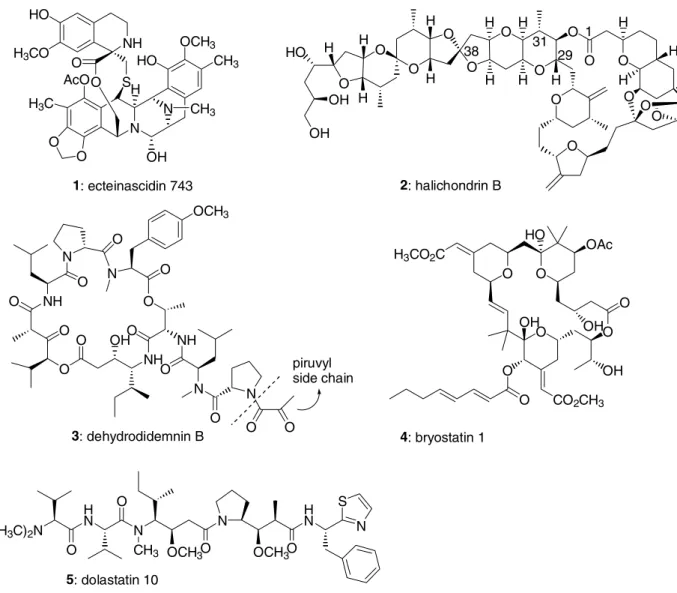

![Table 1: Systematic distribution of sponges of the order Verongida (phylum Porifera, class Demospongiae, subclass Ceractinomorpha) [37] .](https://thumb-eu.123doks.com/thumbv2/1library_info/5513304.1686441/18.892.104.794.175.518/systematic-distribution-sponges-verongida-porifera-demospongiae-subclass-ceractinomorpha.webp)
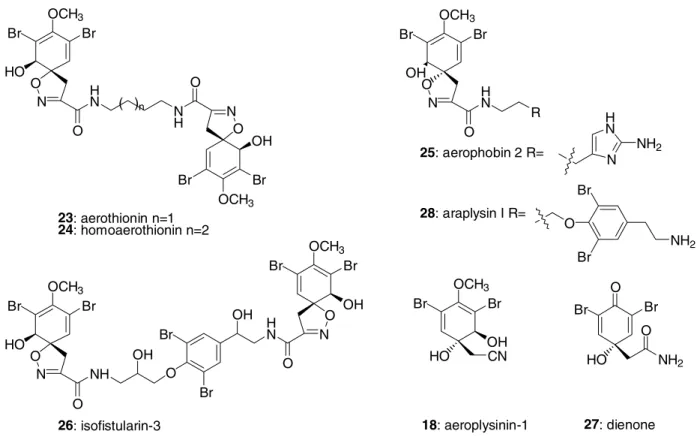
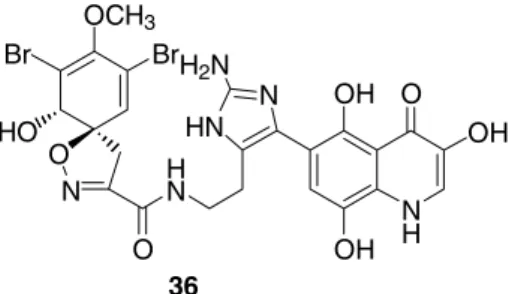
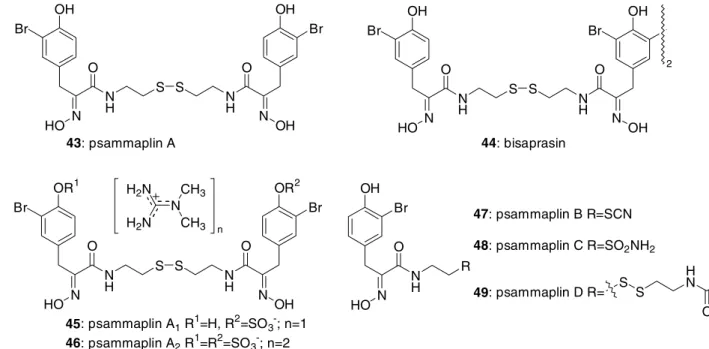
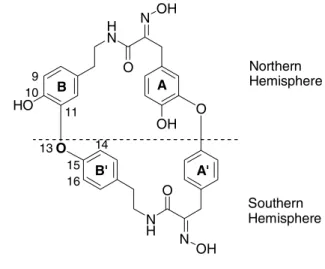
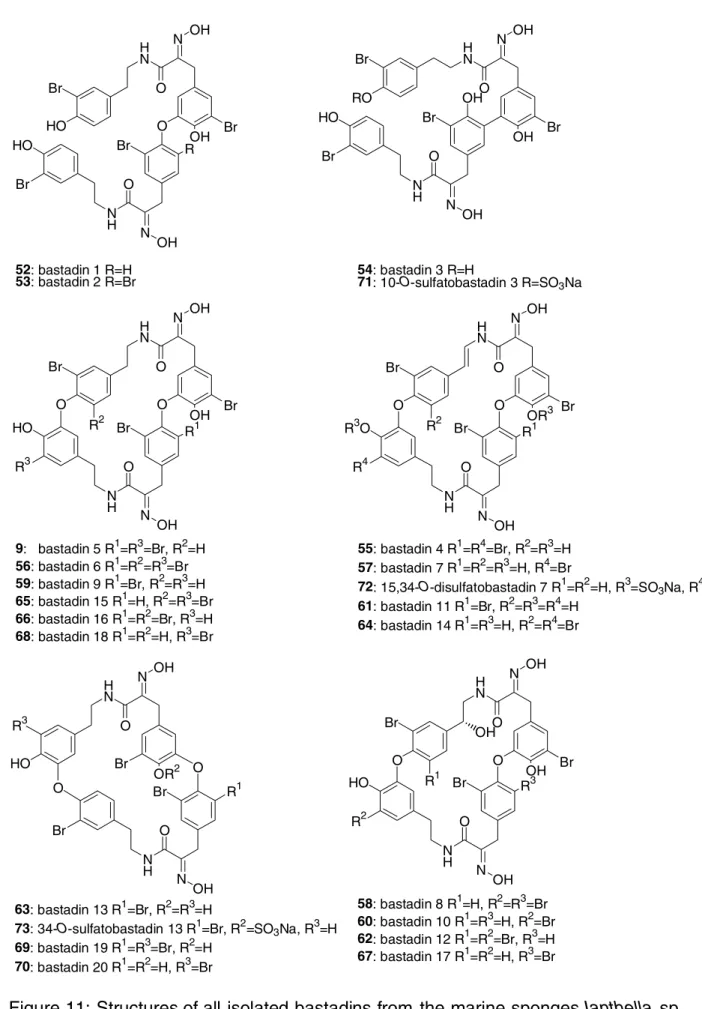
![Figure 13: Components of the electromechanical coupling (excitation-contraction- (excitation-contraction-coupling) in the skeletal muscle [59] .](https://thumb-eu.123doks.com/thumbv2/1library_info/5513304.1686441/27.892.143.751.546.998/components-electromechanical-coupling-excitation-contraction-excitation-contraction-coupling.webp)
![Figure 14: Bastadin 12 skeleton ( 96) and tyrosine cyclic peptides 97 and 98 by Couladouros and Moutsos [31d, e] and by Molinski et](https://thumb-eu.123doks.com/thumbv2/1library_info/5513304.1686441/31.892.107.807.625.872/figure-bastadin-skeleton-tyrosine-peptides-couladouros-moutsos-molinski.webp)